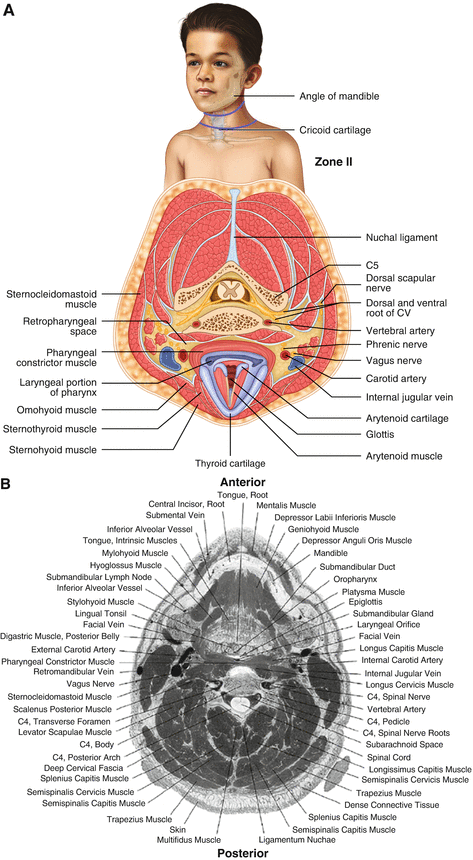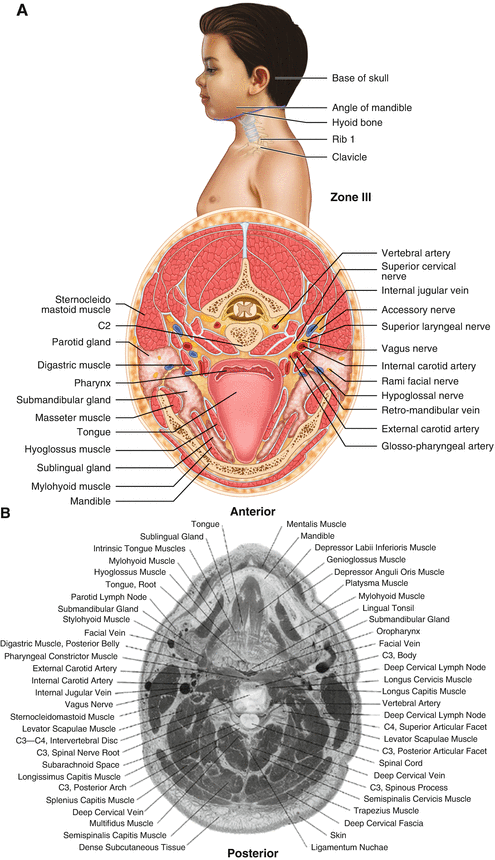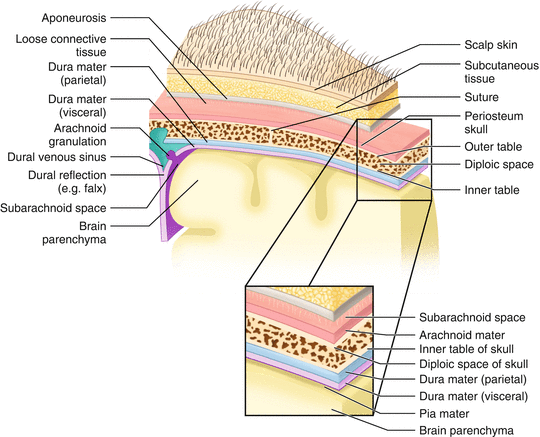Fig. 4.1
Layers of the scalp
Mouth
Mouth injuries are still prevalent in youth sports, despite many sports requiring helmets and/or mouthguards [33]. Intraoral lacerations commonly occur from injury caused by biting of the buccal mucosa. These wounds require evaluation for depth and involvement of the underlying structures. Tongue lacerations typically occur after a fall when the tongue is bitten by the athlete’s teeth. Lacerations that affect the lip should be evaluated for involvement of the vermilion border. Small intraoral lacerations heal without intervention [23]. However, if they are greater than 2–3 cm in length, or have a large flap, these wounds are best closed with 5–0 Vicryl suture [34].
The tongue can be difficult to repair simply because it is a difficult area to access. If there is a large laceration involving the free edge of the tongue, or if there is persistent bleeding, the tongue should probably be repaired. When repairing these lacerations, simple interrupted 4–0 absorbable sutures (e.g., chromic gut) with full-thickness bites are recommended [34]. Tongue lacerations can be difficult to repair due to the patients’ inability to tolerate the procedure and concerns surrounding airway compromise. Sedation may be used when deemed necessary. In situations where the patient’s airway is tenuous, surgical consultation, with repair under general anesthesia, may be warranted [35].
The vermilion border is the area of the lip where the dry mucosa meets the skin of the face. Strict attention to alignment of this border is of great aesthetic importance, so that there is no discontinuity of the lip. A 1-mm discordance can be aesthetically displeasing [36]. Repair of the vermilion border is best achieved using 6–0 nonabsorbable sutures placed in a simple interrupted fashion to first align the edges; repair of the rest of the laceration can follow in standard fashion. Specific care should be taken to maintain the architecture of the lip when using local infiltration of anesthesia. Regional blocks should be used, such as infraorbital and mental nerve blocks, for anesthesia to the upper and lower lip, respectively [37].
Face Lacerations
Careful consideration for the deeper structures of the face when exploring and examining facial lacerations is important. The central portion of the cheek contains the parotid gland and the facial nerve. Notable caution should be taken with injuries close to the tragus of the ear, where the bulk of the parotid gland is located and the facial nerve branches are larger. Other locations to note include outlets of the V1, V2, and V3 branches of the trigeminal nerve—the supraorbital, infraorbital, and mental foramen of the skull, respectively. Wounds that involve ligation of nerves, injury to the parotid gland or Stenson’s duct, or large lacerations that penetrate the oral cavity often necessitate subspecialty surgical consultation.
Neck Contusions, Abrasions, and Lacerations in Youth Sports
Penetrating neck injuries in the pediatric population are rare and are associated with a mortality risk of approximately 10 % [38]. No sports-related mechanisms have been reported in large retrospective reviews in the literature [38, 39]. However, there are case reports of lacerations to the neck in ice hockey from the ice skate blades, leading to significant injuries [40]. A database study reported neck lacerations in football and hockey, but no injuries in soccer [41]. The anatomy of the very young pediatric patient provides relatively good inherent protection to the neck unless the neck is in an extended position [42]. This is secondary to a relatively large head and mandible in relation to the neck. This anatomic protection is less likely in young athletes, as head and neck proportions begin to change quickly, approaching adult proportions when the child is approximately school-age or older.
The spectrum of injury to the neck is broad, spanning from superficial contusions, lacerations, or abrasions to more serious injury to deeper structures. The neck harbors many vital structures including the trachea and relatively superficial large blood vessels. The neck is anatomically broken up into three vertical zones and two anterior and posterior zones.
Zone I—area from the thoracic inlet extending to the cricoid cartilage
Zone II—area from the cricoid cartilage extending to the angle of the mandible
Zone III—area above the angle of the mandible to the base of the skull
Anterior Zone—area anterior to the palpable transverse processes of the cervical spine
Posterior Zone—area posterior to the palpable transverse processes of the cervical spine
These zones are very important to the description and management of penetrating neck injuries.
Zone I
Zone I of the neck includes the area from the thoracic inlet to the cricoid cartilage (see Fig. 4.2). This zone is less protected by the jaw but proportionately smaller in size, as compared to the other zones of the neck. The structures in this region tend to be much deeper which increases the level of protection.


Fig. 4.2
Zone I Anatomy of the neck
Zone II
Zone II of the neck includes the area above the cricoid cartilage and below the angle of the mandible (see Fig. 4.3). Vital structures, such as the major vessels of the neck, traverse this zone very superficially, when compared to the other zones [38]. This zone has the protection of the mandible draping over this region inferiorly, which is more pronounced in younger-aged children versus adolescents. As a result this zone is in the most vulnerable position and exposed to injury, when the neck is in an extended position [42]. Contusions that occur in this zone of the neck are the most likely to cause significant injury given the increased vulnerability to vital structures that this region affords. The structures in this zone will most likely sustain injuries including tracheal injury, which may result in significant subcutaneous emphysema, a large deep hematoma that has the potential to cause airway compromise, and laryngeal injury associated to the triad of stridor, dyspnea, and hemoptysis. Vascular injury from a contusion to this neck zone is unlikely. The carotid artery is the most likely involved vascular structure in this zone of the neck; the most concerning would be intimal tears leading to dissections.


Fig. 4.3
Zone II Anatomy of the neck
Zone III
Zone III of the neck includes the area above the angle of the mandible and extends to the base of the skull (see Fig. 4.4). This area of the neck is well protected from injury by the bony mandible and its relatively small exposed surface. This neck zone should be considered with penetrating injuries that occur in the submaxillary region of the face because the neck extends posterior to the face in this region.


Fig. 4.4
Zone III Anatomy of the neck
Anterior/Posterior
The anterior aspect of the neck contains the most important structures, while the posterior aspect contains mainly bony and muscular structures. However, it can be difficult to determine if the wound extends deeper into the opposite zone, especially in penetrating trauma. The superficial aspect to the neck is remarkable for the platysma muscle, which has its origin in the superior fascia of the pectoralis major and deltoid. It inserts on the mandible and portions of the inferior face [43]. As a result, it spans the majority of the zones of the neck, sparing the most superior portion of zone III. Lacerations to the platysma require sutured repair of the muscle belly itself to maintain its structural integrity.
Clinical Evaluation and Management of Head and Neck Contusions, Abrasions, and Lacerations in Youth Sports
History
Many young athletes are involved in events that lead to contusion, abrasion, or laceration of the head and neck. A thorough history regarding the injury is critical in assisting the healthcare provider assess the need for clinical management. The condition of the wound after injury is determined by the following factors:
Type of insult and area of contact (blunt, penetrating, pointed, sharp, crush, etc.)
Degree of force applied
Direction of force (vertical or tangential)
Area of body affected (to determine possibility of underlying structures being affected)
Timing of the injury
Contamination of the abrasion or laceration (sterile surgical wound, degree of dirt, foreign bodies, etc.)
Environment in which it occurred
General physical condition of the patient (age, associated illness, immune response, etc.)
Tetanus status (if the skin barrier is broken)
Contusions cause swelling and pain and limit joint range of motion near the injury. Torn blood vessels and deep bleeding beneath the soft tissue are responsible for the discoloration of the skin. The injured muscle or tissue may feel weak and stiff. Sometimes a pool of blood collects within damaged tissue, forming a hematoma. The most common sites of soft tissue bruising in children are the head and lower legs [44]. The location of the bruise requires clinical examination for deeper structural injury. In severe cases, swelling and bleeding beneath the skin may be significant. If tissue damage is extensive, suspicion should be heightened for a fracture, dislocated joint, sprain, torn muscle, or other injuries. The extent of the bruising is not a good indication of the amount of force sustained. Commonly there is impressive bruising and few, if any, other clinical signs [44]. If bruising is extensive, has an atypical pattern, and occurs in the absence of trauma or involves only minor trauma, the child may have an underlying preexisting condition or coagulopathy [44].
Examples of abrasions and lacerations to the head and neck in youth sports include abrasions from friction of the helmet strap or a hard surface. Many of the lacerations in the region of the head and neck occur with blunt traumatic force over a bony prominence causing the skin to open. Examples in youth sports with no helmets include a head-to-head collision while attempting a header in soccer or an elbow strike to the cheekbone during a basketball game. In helmeted sports, a significant collision in football may cause the chin strap to lacerate the chin. Other examples of sports causing trauma from sharp objects include ice hockey and lacrosse whereby a skate blade or stick may get caught underneath the helmet in the region of the neck causing injury.
Physical Examination
A comprehensive physical examination , including a detailed neurologic examination, is important to determine the exact location and extent of injury and the need for emergent medical care. If there is a change in mental status or a focal neurologic deficit, further urgent evaluation with advanced diagnostics, including MRI or CT, may be warranted.
Contusions are more difficult to assess accurately given that deeper structures can be damaged without an open wound to view the extent of the injury. It is important to know the underlying anatomy and to separate out deeper pathology from more superficial benign injury. Head contusion physical examination is dependent on the location of the contusion and the mechanism of injury. For example, if the mechanism of injury suggests a major injury (e.g., a high-speed or forceful collision/tackle or a fall from a height of ≥2 m), assessment of the child athlete should begin with a primary survey, including evaluation of airway, breathing, circulation, and conscious state, including a Glasgow Coma Score (GCS). The secondary survey should focus on assessing the location and size of the contusion, areas of ecchymosis, and tenderness or presence of bony step-offs on palpation. Prompt immobilization of the neck and spine is warranted with any concern for neck injury.
The evaluation of lacerations and abrasions is different given the ability to assess structures below within the extent of the wound. A complete physical examination when the skin is broken should include the following steps:
Assess for vascular damage and control bleeding if necessary
Determine the depth of the wound
Explore the wound for foreign bodies and material
Evaluate for any damage to major nerves
Assess for tendon injury
Evaluate the bony structures in the region of the wound
Medical Management
Prior to any treatment, a basic assessment needs to be made either on the field of play or on the sideline depending on the severity of the situation. Initial assessment of the airway, breathing, and circulation (ABC) is crucial in all sports injuries. This is especially important in head and neck injuries because this area is densely packed with structures essential to all of these basic functions. An evaluation of the GCS is also helpful to determine the mental status of an individual who has just sustained a traumatic injury. Finally, when assessing the neck, it is vital to finish the initial evaluation with an assessment of cervical spine stability to ensure proper immobilization when necessary. It is important to make cervical spine stability assessment an integral part of all sports injury management so that life-threatening injuries are not missed.
The decision to treat a young injured athlete on the sideline versus in the emergency department (ED) treatment can be difficult in many cases. The decision many times is obvious; however, in some situations, it is not immediately obvious that referral is required, for example, an athlete who sustains a deep laceration through the ear that penetrates the cartilage. The treating provider must recognize the risk for necrosis and infection, if the wound is not cleaned and closed with a layered sutured repair.
On-Field Treatment
On-field treatment for most injuries should begin with pain, bleeding, and inflammation control using the RICE formula:
Rest. Protect the injured area from further harm by stopping play. Provide protective devices as needed (i.e., crutches, sling).
Ice. Apply ice wrapped in a clean cloth. (Remove ice after 20 min.)
Compression. Lightly wrap the injured area in a soft bandage or ace wrap.
Elevation. Raise it to a level above the heart.
Most athletes with contusions get better quickly with simple treatment measures. The use of nonsteroidal anti-inflammatory drugs (NSAIDs), such as ibuprofen, or other medications for pain relief usually is all that is required for most injuries. It is important to correctly instruct patients with regard to frequent use of ice in the acute phase for pain control and to help control swelling and bleeding. It is important to avoid heat during this phase, as it promotes vasodilatation and can worsen the bleeding. Also, it is important to advise against massage of the injured area. Providing specific instructions regarding elevation above the level of the heart is very important in the acute phase of injury to minimize swelling. For athletes, encouraging cross-training or relative rest while encouraging exercise of the uninjured parts of the body to maintain an overall level of fitness is an important component of the instructions to the injured athlete.
< div class='tao-gold-member'>
Only gold members can continue reading. Log In or Register to continue
Stay updated, free articles. Join our Telegram channel

Full access? Get Clinical Tree


